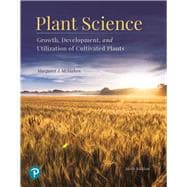For introductory courses in plant science.
Thorough foundation in plant cultivation suitable for learners of all levels
Plant Science: Growth, Development, and Utilization of Cultivated Plants is the premier resource on the basic principles of ecological relationships and their impact on cultivation. Comprehensive and engaging, Plant Science addresses all relevant topics, from the fundamentals of botany to complex cultivation strategies and sustainability concerns. The breadth of topics covered by this text make it ideal for most plant science courses, including the combined agronomy-horticulture curricula that universities are increasingly adopting. The 6th edition has been updated with a wealth of new information, images, and features, and now draws a stronger connection between natural, agricultural, and horticultural ecosystems.










